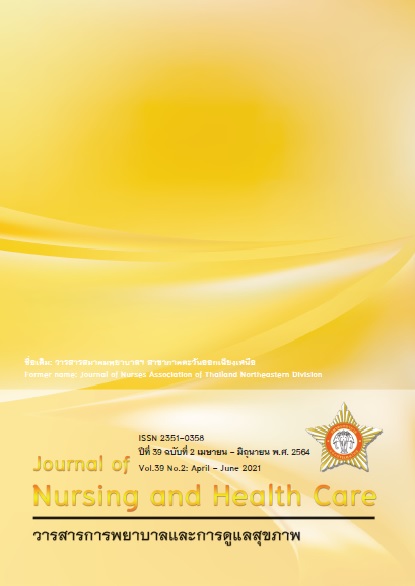การสนับสนุนการจัดการตนเองร่วมกับการใช้กลุ่มเพื่อนช่วยเพื่อนในเด็กวัยรุ่นที่มีภาวะน้ำหนักเกินเพื่อป้องกันโรคไตเรื้อรัง: กรณีศึกษาโรงเรียนมัธยมศึกษาในจังหวัดสุรินทร์
คำสำคัญ:
การสนับสนุนการจัดการตนเอง กลุ่มเพื่อนช่วยเพื่อน เด็กวัยรุ่นน้ำหนักเกิน โรคไตเรื้อรังบทคัดย่อ
การวิจัยครั้งนี้จึงมีวัตถุประสงค์เพื่อ ศึกษาผลของสนับสนุนการจัดการตนเองร่วมกับการใช้กลุ่มเพื่อนช่วยเพื่อนในเด็ก วัยรุ่นที่มีภาวะน้ำหนักเกินเพื่อป้องกันโรคไตเรื้อรัง กลุ่มตัวอย่างแบ่งเป็นกลุ่มทดลองและกลุ่มควบคุมโดยการสุ่มกลุ่มละ 47 คน กลุ่มทดลองได้รับโปรแกรมการสนับสนุนการจัดการตนเองร่วมกับการใช้กลุ่มเพื่อนช่วยเพื่อน ระยะเวลา 6 เดือน ประกอบด้วย 1) ความรู้เกี่ยวกับโรคไตเรื้อรัง 2) การอ่านฉลากเลือกบริโภคอาหาร 3) การออกกำลังกาย 4) การจัดการอารมณ์ 5) การใช้กลุ่มเพื่อนช่วยเพื่อน กลุ่มควบคุมได้รับส่งเสริมสุขภาพตามปกติ การเก็บรวบรวมข้อมูลโดยใช้แบบสอบถามความรู้เรื่องการป้องกันโรคไตเรื้อรัง แบบวัดพฤติกรรมการป้องกัน โรคไตเรื้อรัง มีค่าความเชื่อมั่นเท่ากับ 0.82 และ 0.84 แบบระเมินค่าดัชนีมวลกาย รอบเอว และระดับความดันโลหิต วิเคราะห์ข้อมูลด้วยสถิติเชิงพรรณนา ไคลสแควร์ และสถิติทดสอบค่าที
ผลการวิจัย พบว่า กลุ่มทดลองที่เข้าร่วมการสนับสนุนการจัดการตนเองร่วมกับการใช้กลุ่มเพื่อนช่วยเพื่อน มีค่าคะแนนเฉลี่ยพฤติกรรมการป้องกันโรคไตเรื้อรัง ค่าดัชนีมวลกาย รอบเอว ระดับความดันโลหิต และความรู้เรื่องการป้องกันโรคไตเรื้อรังสูงกว่ากลุ่มควบคุม อย่างมีนัยสำคัญทางสถิติ (P<.05)
สรุป: การสนับสนุนการจัดการตนเองร่วมกับการใช้กลุ่มเพื่อนช่วยเพื่อนในเด็กวัยรุ่นที่มีภาวะน้ำหนักเกินส่งผลต่อพฤติกรรมการป้องกันโรคไตเรื้อรัง
Downloads
เอกสารอ้างอิง
analysis. PLoS One 2016;11:e0158765. 9.
2. Warady BA, Chadha V. Chronic kidney disease in children: the global perspective. Pediatr Nephrol. 2007;22(12):
1999-2009. doi:10.1007/s00467-006-0410-1.
3. World Health Organization. Adolescent health. Retrieved February 9, 2020, from
http://www. who.int/southeastasia/health-topics/adolescent-health.
4. Pongutha S, Khun Puek W. Thailand food and nutrition: where are we now? Nonthaburi; Food and nutrition policy
research program for health promotion foundation for the development of international health policy, 2015.
5. Social Statistics Division National Statistical Office. The 2017 Food Consumption Behavior Survey.National
Statistical Office Ministry of Digital Economy and Society, 2017.
6. Edwardson CL, Gorely T. Parental influences on different types and intensities of physical activity in youth: A
systematic review. Psycho Sport Exer. 2010;11(6):522-35.
7. Pongsaranunthakul Y, Leelahakul V, Wattanakitkrileart D. The relationships between food consumption, exercise and
nutritional status of adolescents in Bangkok Noi district, Bangkok province. J Nurs Sci. 2010;28(3): 30-9.
8. Sanamthong B. Food consumption and exercise behaviors of obese children attending a weight - control program
[master’s thesis]. Khon Kaen: Khon Kaen University;2005.
9. Aekplakorn W. (Editor). Thai National Health Examination Survey, NHES 5th 2014 Nonthaburi: Health Systems
Research Institute; 2014.
10. Tsujimoto T, Sairenchi T, Iso H, et al. The dose-response relationship between body mass index and the risk of incident stage ≥ 3 chronic kidney disease in a general Japanese population: the Ibaraki prefectural health study (IPHS).
Journal of epidemiology 2014;24(6); 444-451.
11. Lorig KR, Holman H. Self-management education: history, definition, outcomes, and mechanisms. Ann Behav Med
2003; 26(1):1-7.
12. Trisirichok P, Uttarasart L, Kankarn W. The impact of self-management support by a multidisciplinary team on
delaying chronic kidney disease progression in primary care, Khon Kaen Regional Hospital. Srinagarind Med J 2019;
34(6):552-8.
13. Meesawat N. Computer mathematics development using the peer-assisted learning strategy. Chiang Mai: Lanna
Polytechnic College; 2013.
14. Glass GV. Primary, Secondary and meta-analysis of research. Educational Research 1976;10:3-8.
15. Sabysook N, Supametaporn P, Songthai N. The effects of a self-management support program on health behaviors
and glomerular filtration rates among type 2 diabetes mellitus patients with stage III chronic kidney disease.
Boromarajonani College of Nursing, Uttaradit Journal 2018;138-50.
16. Cohen J. Statistical power analysis for the behavioral sciences. Second Edition. Hillsdale, NJ: Lawrence Erlbaum
Associates, Publishers; 1988.
17. Polit DF, Hungler BP. Nursing research: Principles and method. (6th ed.). Philadelphia: Lippincott; 1999.
18. World Health Organization. Obesity and overweight. Retrieved May, 17, 2020. from https://www.who.int/en/ news-
room/fact-sheets/detail/obesity-and-overweight.
19. Wisarapun N, KanKarn W, Anutrakulchai S. Effectiveness of a health promotion behavior model to prevent chronic
kidney disease among overweight middle-age women in the Lower Northeastern region. The Journal of Faculty of
Nursing Burapha University 2020;28(3):3-15.
20. Siaa-at B. Statistical methods for research, Volume 1. (5th ed.). Bangkok: Suwiriyasarn; 2013.
21. Creekarl B, Boontum P, Jaistan P. Developing ethnic students’ English speaking skills through the use of peer-
assisted learning activities. CRRU 2017:10(3):77-86.
22. Mongkholmafai J, Songserm N, Kankarn W. The effects of health promotion program and self-help group on
preventive overweight behaviors among village health volunteers in Loei Nok Tha District, Yasothon Province.
Journal of Nursing and Health Care 2018;36(4):1



